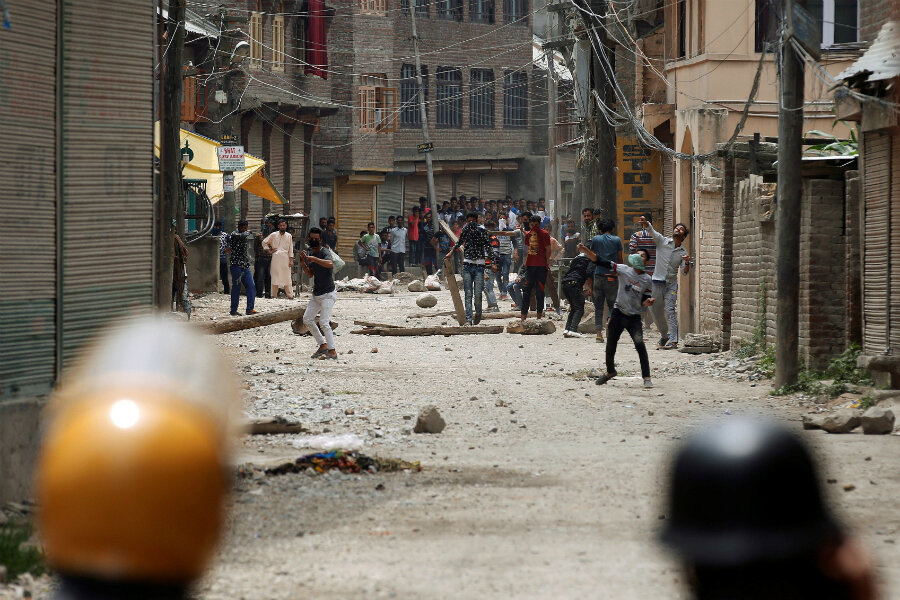Kashmir violence: Why militant's death could become a new rallying point
Loading...
| Srinigar, India-controlled Kashmir
The killing of a popular young militant on Friday in Indian-controlled Kashmir threatens to open a new chapter of violence and agitation in the long-troubled region.
Indian officials have characterized the death of 22-year-old Burhan Wani as one of their "biggest successes." But his popularity among Kashmiris, who rallied around his magnetic rebel tactics and zeal to fight for an independent Kashmir, could make his death a fresh rallying point, energizing protesters in a way not seen since 2010, when civilians confronted government to launch a popular uprising that took four months to contain and inspired a new generation of youth. Kashmir is divided between Indian and Pakistani control, with both nations claiming the entire region.
Already, at least 21 people have been killed and several hundred injured. Police posts have been set on fire and spontaneous stone-throwing clashes have broken out with the government forces. Indian paramilitary forces have attacked ambulances despite a medical emergency being declared.
There has been little widespread violence since the summer of 2010, when at least 110 civilians lost their lives amid heavy protests that followed the extrajudicial killings of several villagers by soldiers. Only in 2013, after the hanging of Mohammad Afzal Guru, a Kashmiri separatist who was convicted for his role in attacking the Indian parliament in 2001, were there large public protests. But tensions have continued to simmer over what many here see as a repressive occupation – and in Wani’s killing, Kashmiris see the loss of a rebellion’s hero, a young man who embodied their political sentiments.
A new face of protest
Seen by supporters as a sort of Che Guevara of Kashmir for his use of social media, video messages, and new methods of recruiting to inspire dozens of young men to pick up guns, Wani sowed the seeds of a new rebellion following his beating by Indian soldiers in 2010, after he and his brother Khalid returned from buying some cigarettes for the soldiers. Wani joined the rebel group Hizbul Mujahideen in October 2010 and advocated armed rebellion in the absence of any political solution, despite peaceful resistance movements.
Indian officials were aware of the potential Wani’s death had to inflame Kashmiris. On Saturday, tens of thousands of people marched toward his native town of Tral, 30 miles south of Srinagar, to offer prayers at his last rites – a series of funeral processions unrivaled for a rebel. A few fellow active rebels also joined to offer 21 salutation rounds of gunfire during his burial.
“The kind of response to Burhan Wani’s killing uncovers the deep rooted alienation and resentment among the people vis-à-vis political situation. He had become a symbol of resistance and his death has been able to invoke this kind of resistance. It could be political disaffection that could become foundation for militancy and violence,” says Noor Ahmad Baba, a political analyst.
Wani gained support for his militancy amid ongoing killings and torture carried out by Indian troops. In the past 27 years, around 70,000 people have been killed and 8,000 have disappeared; tens of thousands of people have been charged for anti-national activities. A senior military commander recently said that the Army, estimated more than half a million personnel in Kashmir, is losing the battle for the narrative, and it has become difficult to conduct anti-rebel operations due to strong public support.
However, the Intelligence Chief of the police, S. M. Sahai, told a news agency that the large number of protests does not signify support for Wani, arguing instead that there are many other issues that complicate youths’ lives, and that they should pursue education and jobs. Critics counter that many who protest belong to affluent families, suggesting that financial woes are not driving force for protest.
Need for a political solution
Opposition leader and former chief minister Omar Abdullah said that political solutions are needed. "Alas Burhan isn't the 1st to pick up the gun & won't be the last. [JK National Conference] has always maintained that a political problem needs pol. solution," Abdullah tweeted.
Mr. Sahai, said that the police didn’t want to kill Burhan, which he said happened when Wani and two other rebels fired at soldiers. “It was not a 'kill Burhan' operation,” he said. “We don’t want to kill militants –if they surrender that is better. But sometimes situation is unavoidable; if they open fire then we also retaliate with bullets.”
Khurram Parvez, a prominent human rights activist, calls Wani a “political ideologue” of Kashmir more than a militant, and is critical of India’s conduct. “Around 20 people have been killed in the last two days; it will also have impact. India disregards peaceful protests like in 2008 and 2010, so the onus of a rise in militancy is on India.”
Since the 2010 uprising, there has been little progress on improving the political disputes underlying the protests. No official was prosecuted for the civilian killings in 2010 or for other human rights violations since then. Despite some development initiatives, the violence against civilians has continued, and Kashmir has witnessed a renewed anti-India sentiment. The partnership of the local People’s Democratic Party with India’s Bhartiya Janta Party to form a regional government has further amplified public anger, with people feeling they have little space to express dissenting voices.
“Nobody talks about the Kashmir dispute – the root of the issue,” says Mr. Baba, the analyst. “People would say the situation will improve in Kashmir but the ongoing protests have shown we are back at square one.”







